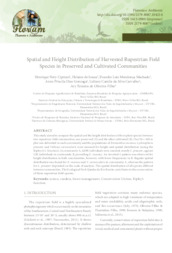Spatial and Height Distribution of Harvested Rupestrian Field Species in Preserved and Cultivated Communities.
Spatial and Height Distribution of Harvested Rupestrian Field Species in Preserved and Cultivated Communities.
Author(s): CIPRIANI, H. N.; SOUSA, H. de; MACHADO, E. L. M.; GONZAGA, A. P. D.; CARVALHO, L. C. da S.; OLVEIRA FILHO, A. T. de
Summary: This study aimed to compare the spatial and the height distribution of three plant species between two rupestrian field communities, one preserved (A) and the other cultivated (B). One 50 × 100 m plot was delimited in each community and the populations of Eremanthus incanus, Lychnophora pinaster and Vellozia caruncularis were assessed for height and spatial distribution (using the Ripleys?s L-function). In community A, 4,098 individuals were counted, mostly L. pinaster, against 220 individuals in community B, prevailing E. incanus. An inverted-J pattern was observed for height distribution in both communities, however, with lower frequencies in B. Regular spatial distribution was found for E. incanus and V. caruncularis in community A, whereas the pattern for L. pinaster depended on the scale of analysis. The spatial distribution of all species differed between communities. The Ecological Park Quedas do Rio Bonito contributes to the conservation of these rupestrian field species.
Publication year: 2016
Types of publication: Journal article
Unit: Embrapa Rondônia
Keywords: Arnica, Candeia, Conservation Unities, Ripley’s function, forest management
Observation
Some of Embrapa's publications are published as ePub files. To read them, use or download one of the following free software options to your computer or mobile device. Android: Google Play Books; IOS: iBooks; Windows and Linux: Calibre.
Access other publications
Access the Agricultural Research Database (BDPA) to consult Embrapa's full library collection and records.
Visit Embrapa Bookstore to purchase books and other publications sold by Embrapa.

